HIGHLIGHTS OF THE STORY (source : Gallup, 18/12/2023)
- Many organizations are rethinking the way they do business
- Relationships between workers and organizations are changing
- To succeed in 2024, leaders must rethink their approach to people management
In 2024, employers and employees are heading for a reset in their relationship.
This shift stems in part from changes in where and how people work. In 2019, 60% of employees with the option of working remotely spent their entire week working fully on site, whereas this figure has fallen to just 20% in 2023.
But that doesn’t tell the whole story. Nearly half of American employees work entirely onsite in jobs that can’t be hybrid or remote. And according to Gallup’s research, the way employees are managed influences employee engagement and well-being around four times more than their workplace.
Essentially, it’s workers’ relationships with their colleagues, their managers, their leaders and their organization that are changing significantly. Many organizations are radically rethinking the way they work, leaving many employees, including managers, stressed and disconnected.
For example, when Gallup asked managers what changes their organization had made in 2023:
64% said employees were given additional responsibilities, 51% mentioned team restructuring and 42% reported budget cuts. To succeed in 2024, leaders should consider revising their management strategies to better support the changing needs of their workforce and organizational culture. We recommend starting with a plan to assess and address the following six trends that leaders should pay attention to within their own organizations:
1. Global worker stress remains at record levels
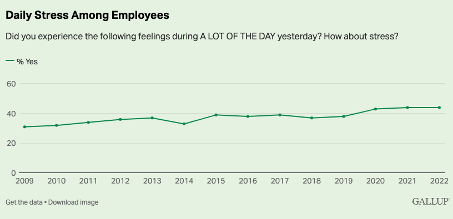
Gallup’s recent State of the Global Workplace report revealed that employee engagement is on the rise worldwide. This is good news. However, worker stress has remained at record levels since the pandemic. In the US and Canada, employee stress is even higher, with 52% of employees reporting feeling a lot of stress the previous day. This trend has implications for people’s well-being at work and at home, as well as for their productivity and longevity. As we enter the year 2024, which trend will prevail: a continued rise in stress or improved employee engagement? Read: Globally, employees are more engaged – and more stressed (gallup.com)
2. The engagement is slowly recovering, with a few points to improve
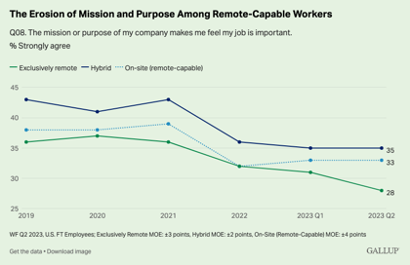
Employee engagement levels in the US began to slowly recover in 2023 after a post-pandemic slump. But a particularly worrying trend is the decline in the number of employees who feel connected to their organization’s mission and purpose. This sense of connection inspires employees to go beyond the basic requirements of the job and strive for excellence. It also significantly boosts loyalty and retention.
Read: Are remote workers and their organizations drifting apart? (gallup.com)
3. Leaders restore trust but still have plenty of room for improvement
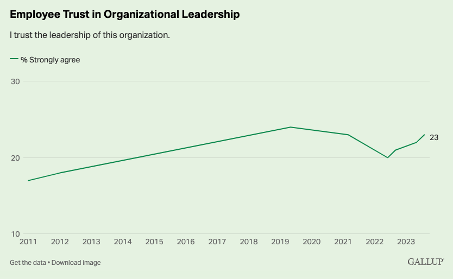
Confidence in organizational leadership declined sharply from the start of the pandemic until it began to recover in 2023. Yet today, only 23% of American employees strongly agree that they trust their organization’s leadership. Undoubtedly, the trials and disruptions of today’s new world of work have created headwinds for leaders. However, when leaders communicate clearly, lead and support change, and inspire confidence in the future, 95% of employees say they fully trust their leaders.
Read: Why trust in leaders is faltering and how to gain it back (gallup.com)
4. Managers are put under pressure
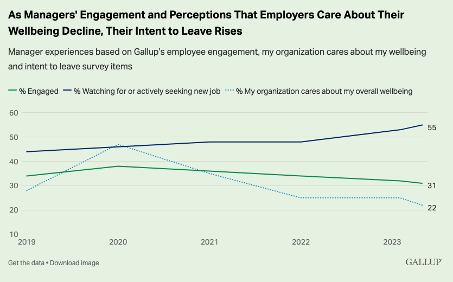
Changes in the workplace have particularly affected managers. In 2023, managers were more likely than non-managers to be disengaged, burnt out and looking for work. They were also more likely to feel that their organization did not care about their well-being, and to report that they found it difficult to balance work and personal life.
Managers’ difficulties are bad news for organizations, as they have a knock-on effect on their teams. Managers play a crucial role as facilitators of team collaboration and effectiveness, accounting for 70% of the variance in employee engagement.
Overall, “pressure on managers” stems largely from increased responsibilities and navigation through numerous organizational changes. Gallup’s research shows that many managers now have more work to do with tighter budgets and new teams. And from a relational point of view, they often find themselves caught between aligning with new executive directives and meeting the changing expectations of their employees.
What is certain is that managers will need more training and support to lead effectively in today’s work environment, filled with new expectations for managers.
Read: The manager squeeze: how the new workplace is testing team leaders (gallup.com)
5. Organizations need a long-term hybrid working strategy
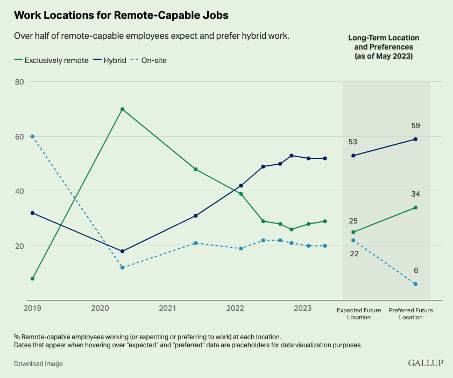
Since mid-2022, workplace trends for the US workforce have largely stabilized, implying that most employees currently work where they plan to work for the foreseeable future, according to employer communications. A separate survey of HR directors at Fortune 500 companies found that eight out of ten had no plans to reduce the flexibility of remote working in the next 12 months.
Given that hybrid working has become the norm for workers able to work remotely, and that people have largely settled into their new routines, it’s time for leaders to optimize their hybrid workplace. This means doing things like creating a compelling workplace value proposition, enabling teams to collaborate more effectively, overhauling performance management systems and training managers to become great hybrid coaches.
Read: The future of the office has arrived: it’s hybrid
6. Hybrid culture can be great – if it’s done right
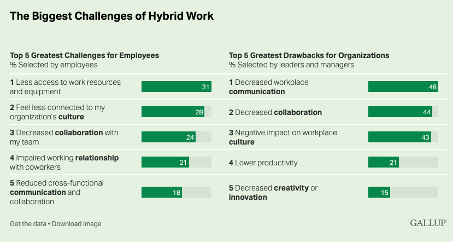
Hybrid working offers the benefits of a more flexible working environment, while also posing some unique challenges. In terms of benefits, hybrid workers have higher engagement, better overall well-being and lower turnover risk than fully on-site workers who have the ability to work remotely – which is also good for business. Leaders and managers tend to recognize these benefits, reporting that hybrid working has reduced burnout, improved retention and expanded talent pools in their organizations.
At the same time, working more often separately and on different schedules creates new obstacles. Organizations planning to pursue hybrid working in the long term need to thoughtfully create and fully commit to a strategy on how they best communicate, collaborate, build relationships and consolidate their work culture.
Read: The future of the office has arrived: it’s hybrid


